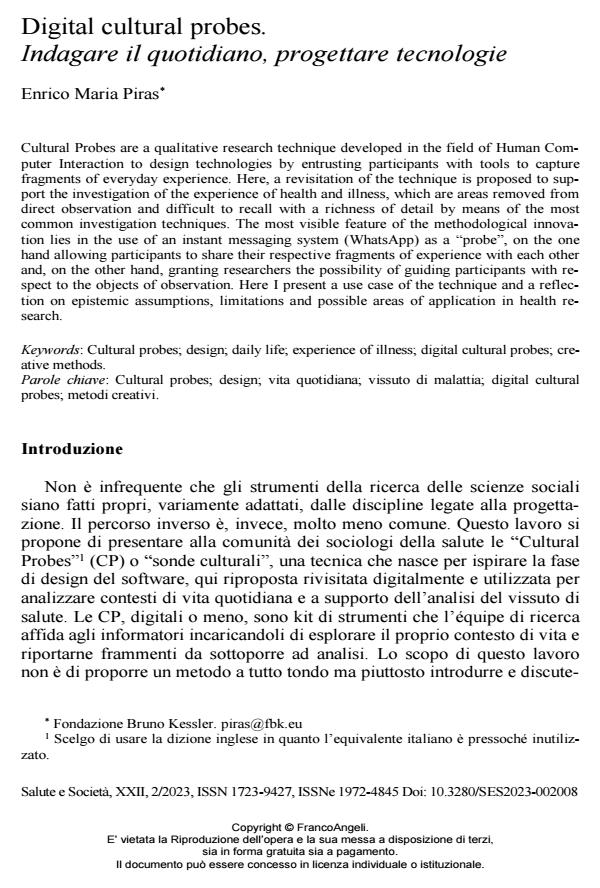Digital cultural probes. Indagare il quotidiano, progettare tecnologie
Journal title SALUTE E SOCIETÀ
Author/s Enrico Maria Piras
Publishing Year 2023 Issue 2023/2 Language Italian
Pages 12 P. 80-91 File size 425 KB
DOI 10.3280/SES2023-002008
DOI is like a bar code for intellectual property: to have more infomation
click here
Below, you can see the article first page
If you want to buy this article in PDF format, you can do it, following the instructions to buy download credits

FrancoAngeli is member of Publishers International Linking Association, Inc (PILA), a not-for-profit association which run the CrossRef service enabling links to and from online scholarly content.
Cultural Probes are a qualitative research technique developed in the field of Human Com- puter Interaction to design technologies by entrusting participants with tools to capture fragments of everyday experience. Here, a revisitation of the technique is proposed to sup- port the investigation of the experience of health and illness, which are areas removed from direct observation and difficult to recall with a richness of detail by means of the most common investigation techniques. The most visible feature of the methodological innova- tion lies in the use of an instant messaging system (WhatsApp) as a "probe", on the one hand allowing participants to share their respective fragments of experience with each other and, on the other hand, granting researchers the possibility of guiding participants with re- spect to the objects of observation. Here I present a use case of the technique and a reflec- tion on epistemic assumptions, limitations and possible areas of application in health re- search.
Keywords: Cultural probes; design; daily life; experience of illness; digital cultural probes; cre- ative methods.
- Piras E.M. (2021). Il disegno partecipato di tecnologie per il benessere degli anzia- ni: il caso del sistema WellCo. In: Sangalli C., Trabucchi M., a cura di, Ipotesi per il futuro degli anziani. Tecnologie per l’autonomia, la salute e le connes- sioni sociali. Bologna: Il Mulino.
- Piras E.M., Zanutto A. (2010). Prescriptions, x-rays and grocery lists. Designing a Personal Health Record to support (the invisible work of) health information management in the household. Computer Supported Cooperative Work (CSCW), 19: 585-613.
- Robertson S.K. (2008). Cultural probes in transmigrant research: a case study. InterActions: UCLA Journal of Education and Information Studies, 4(2): 1-26. DOI: 10.5070/D44200062
- Rodríguez I., Puig A., Tellols D., Samsó K. (2020). Evaluating the effect of gami- fication on the deployment of digital cultural probes for children. International journal of Human-Computer studies, 102395.
- Star S.L., Strauss A. (1999). Layers of silence, arenas of voice: The ecology of vis- ible and invisible work. Computer supported cooperative work, 8: 9-30. DOI: 10.1023/A:100865110535
- Mair F.S., May C.R. (2014). Thinking about the burden of treatment. Bmj, 349.
- Kjeldskov J., Gibbs M., Vetere F., Howard S., Pedell S., Mecoles K., Bunyan M. (2004). Using Cultural Probes to Explore Mediated Intimacy. Australasian Journal of Information Systems, 11(2): 102-115.
- Guillemin M., Gillam L. (2004). Ethics, reflexivity, and “ethically important mo- ments” in research. Qualitative Inquiry, 10: 261-280. DOI: 10.1177/107780040326236
- Giorgi A., Pizzolati M., Vacchelli E. (2021). Metodi creativi per la ricerca sociale. Contesto, pratiche e strumenti. Bologna: Il Mulino.
- Gaver W. (2002). Designing for homo ludens. I3 Magazine, 12: 2-6.
- Gaver W., Dunne T., Pacenti E. (1999). Cultural Probes. ACM Interactions, 6: 21-29. DOI: 10.1145/291224.29123
- Crabtree A., Hemmings T., Rodden T., Cheverst K., Clarke K., Dewsbury G., Hughes J., Rouncefield M. (2003). Designing with care: Adapting cultural probes to inform design in sensitive settings. Proceedings of the 2004 Australa- sian Conference on Computer-Human Interaction, 4-13.
- Cardano M. (2020). Argomenti per la ricerca qualitativa. Disegno, analisi, scrittu- ra. Bologna: Il Mulino.
- Debord G. (1998). Theory of the Dérive. In: Sellars J., a cura di, Nomadic Trajec- tories. Coventry: Warwick Journal of Philosophy.
- making visible mundane material culture in health and social care con- texts. Sociology of health & illness, 40: 243-255. DOI: 10.1111/1467-9566.1266
- Blumer H. (1969). Symbolic interactionism. Englewood Cliffs, NJ: Prentice-Hall. Buse C., Martin D., Nettleton S. (2018). Conceptualising 'materialities of care':
Enrico Maria Piras, Digital cultural probes. Indagare il quotidiano, progettare tecnologie in "SALUTE E SOCIETÀ" 2/2023, pp 80-91, DOI: 10.3280/SES2023-002008